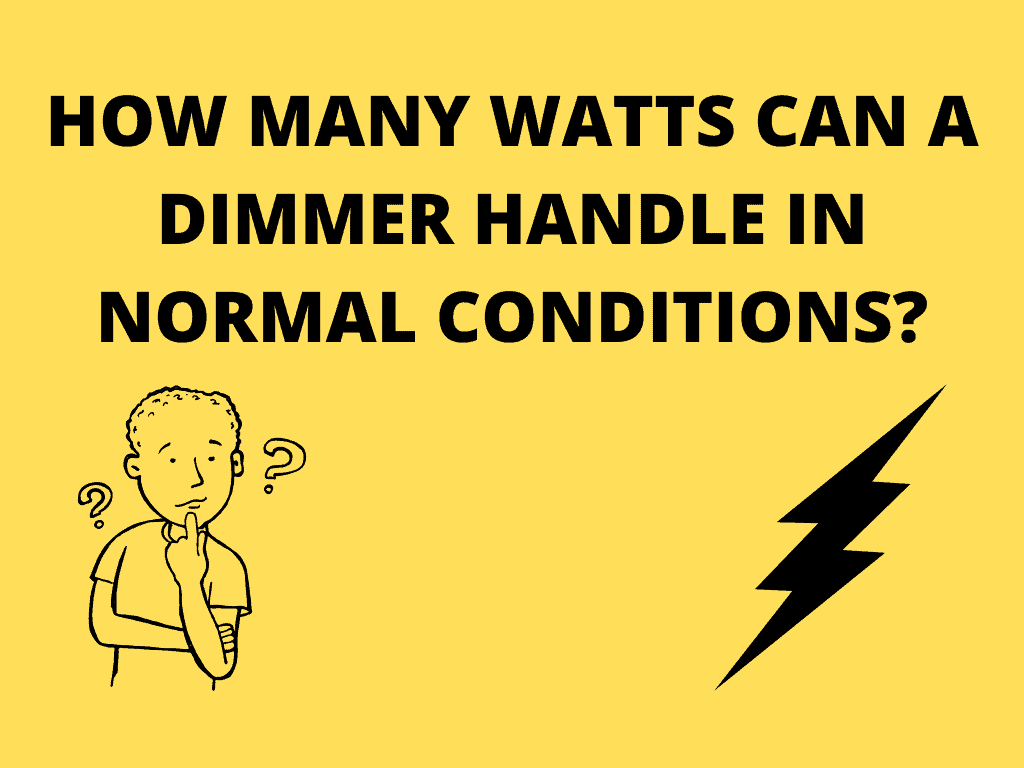How many watts can a dimmer handle in normal conditions?
Dimmer switches can handle bulbs from 1 Watt to 1000 Watts.

Some dimmers can even handle different bulb types in the same circuit.
Not all dimmer switches are the same, and if you get one that’s not rated for the total wattage of the lights you want it to control, you could have problems. So bu sure to check the fine print before you buy it. And if you decide to replace an old dimmer, make sure the wattage rating on your new dimmer is at least as high as the old one.
Check the dimmer switch rating
Usual dimmer wattage ratings are 150 watts, 300 watts, 600 watts, and 1000 watts. 150 watt rated dimmers are usually for a single bulb circuit.
Rating when installing dimmers
If you’re planning on installing a dimmer switch, you should keep in mind that each switch is rated to handle a maximum wattage.
If you’re trying to dim five 100-watt bulbs, use a switch rated for at least 600 watts.
Dimmer wattage calculation example:
- Multiply the number of fixtures by the wattage rating of each fixture.
- Multiply the result by 125 % (continuous load).
- Round up to the next dimmer wattage rating.
Example with five 60W bulbs:
- 5 light fixtures.
- 60-watt fixture rating.
- Multiply the result by 125% (1.25).
- 5 fixtures x 60 watts = 300 watts.
- 300 watts x 1.25 = 375 watts.
- You should choose the next higher wattage dimmer rating = 375W or higher dimmer.
LED Dimmer Switch Wattage Calculation
An easy rule to remember when calculating the load for LED dimmers is to divide the stated (on the dimmer or the package) maximum load by 10. For example, a 500W dimmer switch should have no more than 50W of LED bulbs connected to it, which would equate to 10 5W bulbs.
Has This Ever Happened To You?
You have done your homework and confirmed that the dimmer you have just purchased is compatible with your LED bulbs.
Now comes the time to test out the performance and you’re not getting what you were expecting.
This is because compatibility is just one part of the dimming equation.
The dimmer you have has several electrical requirements that must be met in order to ensure good performance.
A couple of these requirements are minimum and maximum loads.
What is maximum load and calculating the maximum load
Dimmers also have maximum load requirements to ensure the load does not exceed the dimmer’s design limits.
The low wattage of LED bulbs means that in theory, you could connect numerous bulbs to the same dimmer switch. If you have a dimmer switch with a 400W maximum load, for example, then surely you could connect 40 10W LED bulbs to it (40 x 10W = 400W)? Well, it`s not exactly like that.
LED bulbs generate a spike of power when switched on, which may surpass the stated wattage of the bulb for a moment.
A rule of thumb commonly used to calculate a load for LED dimmers is to divide the stated maximum load by 10. For example, a 400W dimmer switch should have no more than 40W of LED bulbs connected to it, which would equate to ten 4W bulbs.
What can happen if you surpass maximum loads?
- Surpassing these limits can result in dimmer failure, flickering due to noise, as well as breaker tripping.
- One of the main reasons dimmers have maximum loads is because of the inrush current caused by LED drivers.
- Inrush current is an input current of short duration during initial start-up that exceeds the steady-state current value.
Minimum Loads – Dimmers have minimum load requirements.
You may be asking why?
It’s because if the LED load isn’t using enough current to keep the dimmer’s switching elements closed, the dimmer will have irregular behavior. This behavior can include flickering, bad dimming range, flashing when off, or not even working at all.
This means that dimmers that are designed for incandescent loads tend to have a higher minimum load requirement because incandescent fixtures usually have higher wattages than LED fixtures.
This means that these dimmers will require multiple LED fixtures to meet the minimum load requirement.
Led dimmer load requirement
Dimmers that are designed for LED loads normally have a much lower minimum load requirement and usually, only require one or two fixtures. The LED minimum load rating for LED loaded dimmers is usually given in the number of lamps instead of Watts (W) or Volt-Amps (VA).
Lutron C.L Dimmers can control up to 17 bulbs and is the only dimmer UL listed to control mixed loads (different types of bulbs, such as LEDs and halogens, on the same circuit).

Summary
To learn the actual load requirements for a particular dimmer and fixture, testing must be done.
Minimum and maximum load requirements differ between incandescent fixtures and LED fixtures.
Even when meeting the load specifications, flicker may still appear if you are trying to dim lower than the rating of the LED driver.
Adjusting the low-end trim of the dimmer can usually fix this.

